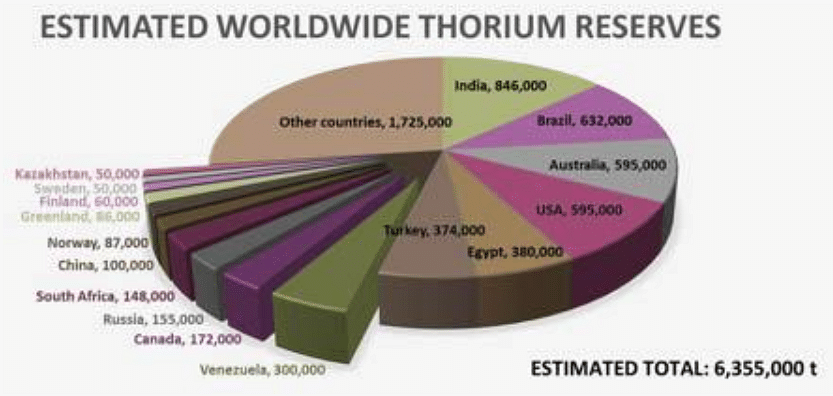Thank you dear subscribers, we are overwhelmed with your response.
Your Turn is a unique section from ThePrint featuring points of view from its subscribers. If you are a subscriber, have a point of view, please send it to us. If not, do subscribe here: https://theprint.in/subscribe/
India, on the brink of an energy revolution, holds the key to a sustainable future with its vast Thorium reserves. This could satisfy its growing energy needs and establish it as a pioneer in global energy innovation.
In 2024, currently, India commenced the start of Thorium fuel loading at the 500 MWe Prototype Fast Breeder Reactor at Kalpakkam in Tamil Nadu. Fast breeder reactors form the second stage of India’s three-stage nuclear programme.
nnovations like the Thorium-powered car concept, which promises a million miles of travel on just eight grams of Thorium, further underscore the metal’s vast potential. This leap in vehicular technology mirrors the strides India could make in energy, revolutionizing not just power generation but transportation as well.
The Thorium Context
India is home to the world’s largest reserves of Thorium, a slightly radioactive metal that promises a cleaner and more efficient alternative to conventional nuclear fuels. With an estimated 11.93 million tonnes of monazite, containing about 1.07 million tonnes of Thorium, India’s energy future could be bright and long-lasting. The Thorium reserves are believed to have the potential to produce 500 GWe for at least four centuries, solely using the country’s economically extractable Thorium.
Thorium’s Potential
Thorium’s allure as a nuclear fuel lies in its abundance and its ability to breed fissile material. Unlike Uranium, Thorium-232 is not fissile itself but is ‘fertile’. When irradiated, it undergoes nuclear reactions to form Uranium-233, which can then be used to release energy in a nuclear reactor. This process not only makes Thorium a more sustainable option but also reduces the long-term radioactivity of the waste produced.
India’s Three-Stage Nuclear Power Programme
India’s approach to harnessing Thorium is encapsulated in its ambitious three-stage nuclear power programme. The first stage involves using pressurized heavy water reactors to produce Plutonium. The second stage uses this Plutonium to fuel fast breeder reactors that, in turn, breed more fissile material from Thorium. The final stage envisages advanced heavy water reactors that will utilize Thorium directly.
Challenges and Solutions
Despite its potential, Thorium’s path to becoming a mainstay in energy production is fraught with challenges. The extraction of Thorium is currently expensive, and the technology for its utilization in reactors is still in the developmental phase. Moreover, Thorium needs a ‘driver’ like Uranium or Plutonium to maintain a chain reaction, which adds complexity to the process.
To overcome these hurdles, India has been investing in research and development. The Advanced Heavy Water Reactor (AHWR) is one such innovation, designed to use Thorium as its primary fuel and incorporating passive safety features. The successful core loading of the Kalpakkam fast breeder reactor marks a significant milestone, demonstrating the feasibility of converting Thorium to usable fuel.
India’s advantage over the rest of the world
From the following, India is the Saudi Arabia of Thorium with the largest reservoirs that are also cost-effectively attainable.

The Road Ahead
For India to leapfrog into energy supremacy with Thorium, a multi-faceted approach is necessary. This includes:
- Investment in R&D: Continued investment in research and development is crucial for refining Thorium reactor technology and making it commercially viable.
- International Collaboration: Engaging in partnerships with other nations interested in Thorium research can accelerate technological advancements and share best practices.
- Policy Framework: Establishing a robust policy framework that supports the development of Thorium-based reactors while ensuring safety and non-proliferation.
- Public Awareness: Educating the public about the benefits of Thorium energy can garner support and address any concerns related to nuclear energy.
- Infrastructure Development: Building the necessary infrastructure for Thorium extraction and reactor construction is essential.
Thorium’s potential extends beyond just fueling reactors; it could revolutionize energy storage in electric vehicles (EVs). As a power source for utilities, Thorium’s high energy density means it can be used to generate electricity efficiently. This electricity could then be stored in Thorium-based nuclear batteries within EVs, providing a much higher energy storage capacity compared to traditional batteries. The result is an EV that not only has an incredibly long range but also contributes to a cleaner environment by reducing the need for frequent recharging and utilizing a more sustainable fuel source.
Conclusion
India’s Thorium reserves are not just a resource; they are a beacon of hope for a sustainable energy future. By leveraging its vast Thorium deposits, India can not only achieve energy independence but also lead the world towards a cleaner, safer, and more sustainable energy paradigm. The journey will be challenging, but the rewards could redefine India’s role in the global energy landscape, making it a forerunner in the race towards a greener tomorrow.
These pieces are being published as they have been received – they have not been edited/fact-checked by ThePrint


